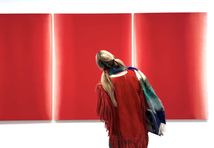Head of a [___] Man
- The Courtauldian
- Nov 21, 2020
- 4 min read
How the British Museum continues to center whiteness when describing prints of Black and white men.
by Sara Blad | 21 November 2020

Mezzotint by Wallerant Vaillant. Described as a ‘[h]ead of a black man looking to right’. Photo: British Museum.

Drawing by Lorenzo Lotto. Described as a ‘[h]ead of a man wearing a cap’. Photo: British Museum.
Prompted by George Floyd’s murder in the United States and the global Black Lives Matter protests that followed, the British Museum decided to publicly come to terms with its colonial legacy. After closing during a Covid-19 outbreak, the museum reopened in August 2020 with a desire ‘to better reflect our societies and our complex, contentious and blended histories, and become more than ever a theatre of human connection’. Despite these encouraging words, many have rightly condemned the British Museum for again failing to address repatriating stolen objects from around the world. What received less attention, but is still deserving of a public reckoning, is how the museum continues to center whiteness in how it describes its print collection. The British Museum made two immediate changes to acknowledge its links to slavery. The museum first visually de-centered Hans Sloane, a slave owner and one of the museum’s founding collectors. While the museum previously put him on a pedestal (literally) Sloane’s bust now resides in a vitrine with other objects to illustrate elements of the British empire and Slave Trade. The museum also created a new ‘Collecting and Empire’ guided tour in which object labels describe how the museum acquired particular objects.

Drawing by Antoine Watteau. Described as a ‘[h]ead of a man with eyes lowered and head tilted back’. Photo: British Museum.

Etching by Thomas Worlidge. Described as a ‘[p]ortrait bust of unidentified young black man’. Photo: British Museum.
Many criticized these actions as ignoring the heart of the problem: that the museum’s collections are filled with looted objects. Alex Marshall of The New York Times notes that the ‘Collecting and Empire’ guided tour panels stress that people mostly either donated or brought the objects to the museum, rather than stole them. Specifically highlighting the Benin Bronzes and the Gweagal shield, Bayryam Mustafa Bayryamali wrote that the British Museum holds looted objects hostage, separating them from their communities with ‘alarms, vitrines, walls, guards, and borders’. Kehinde Andrews argues that the British Museum ‘is one of the worst offenders when it comes to the problems of how we remember history. With its treasure trove of stolen artifacts and historical amnesia over empire, it has a long way to go before we can say it’s headed in the right direction’. These are valid criticisms, despite the protests of Director Hartwig Fischer that the museum’s collection is not ‘based on looted objects’. Instead, he argues that objects acquired by passionate scientists and collectors are at the ‘heart of this institution’, making it ‘the most extraordinary place to learn about humankind and its history’.

Pen lithograph by William Toovey after Henri Van Der Haert. Described as ‘[t]wo heads of a black man’. Photo: British Museum.

Drawing by Marie Françoise de Saint-Aubin. Described as a ‘[h]ead of a man’. Photo: British Museum.
The reality that Fischer is unwilling to accept is that white supremacy pervades every part of the British Museum. We see this in the way the museum describes prints of Black and white men. Modes of classification—such as titles and keywords—may make it easier for readers to easily identify a specific illustration in written text or in the British Museum’s online collection database. But beyond retrieval, these categorizations can perpetuate pernicious ideologies when applied to representations of people. And in a structurally racist society, what may initially seem like a trivial issue of semantics actually has the power to reinforce racist frameworks through which viewers interpret the collection objects.

Drawing by Anonymous (German School). Described as a ‘[h]ead of a man’. Photo: British Museum.

Drawing by Glyn Philpot. Described as a ‘[s]tudy of a standing black man (the artist’s Jamaican servant Henry Thomas)’. Photo: British Museum.
How and when the British Museum decides to describe skin colour reinforces white supremacist ideology. Curators describe prints of Black men—such as those by Wallerant Vaillant, Glyn Philpot, William Toovey, and Thomas Worlidge—as images of ‘black men’. (As an aside, ‘black’ is not capitalized when used to describe Black people in the object descriptions, however; Fischer does capitalize black as a descriptor of personhood in his response to George Floyd’s death). Curators describe prints of white men—such as those by Lorenzo Lotto, Marie Françoise de Saint-Aubin, an anonymous German artist, and Antonine Watteau—as heads of a ‘man’. These discrepancies insinuate that the British Museum believes that the most important element of an illustration of a Black man is his skin colour, which subtly dictates the viewer’s experience of his image. This uneven inclusion of race as a descriptor across prints of both Black and white men presents whiteness as the default from which others deviate. If the museum specifies one person’s skin colour, it should specify everyone’s skin colour.
This is not to say that correcting descriptors is the solution for the British Museum’s desire to ‘fight against inequality and discrimination’ and address and work toward redressing its colonial legacy. But language matters, and it is an important step along the way. Changing the language that the museum uses to center whiteness should occur in tandem with cultural restitution, repatriation, new guided tours, diversifying its employees (only one out of 150 curators is Black) and other means of change and reckoning.












Comments